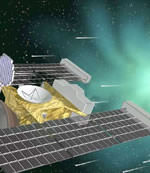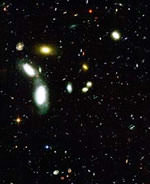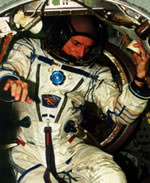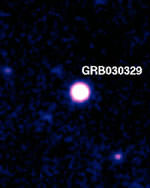Interested in space and astronomy but you’ve never actually looked through a telescope? Until you’ve actually gone out and done some actual observing with your own two eyes, you won’t know what you’re missing. In this article, Fraser gives you a kick in the pants to get out there under the skies and start enjoying the heavens above. You don’t need any special equipment or advanced university degrees, just some enthusiasm, a little time and the ability to look up.
I know there are a lot of subscribers interested in space and astronomy, but I’m wondering how many of you have actually taken a look through a telescope and seen some of the objects I talk about with your own eyes.
One of my fondest memories was when I was 13 years old, and set up my 4″ telescope at my Dad’s birthday party. I was in a darkish corner of our property and would sneak away a few partygoers to show them Saturn. Fortunately the rings were at their greatest angle, and people looking through the eyepiece couldn’t believe their eyes. Looking at pictures taken by Hubble is one thing, but when you’re actually looking through the eyepiece at Saturn, it’s an incredible experience.
Stargazing has since played a big part of my life: I organized a star party, hit on my future wife by pointing out constellations, and started a space-related website, but I’m still amazed at the number of people who’ve never actually gone out there and gotten to know their sky.
With all the new observatories and space news, I think that people are starting to think that astronomy is one of those sciences reserved for people with the expensive instruments, but that couldn’t be further from the truth. It’s one of the few sciences that amateurs still make valuable contributions, and it costs absolutely nothing to get started – you just need your eyes, and a little knowledge.
Find your community
The first thing you need to do is make a commitment to get involved in astronomy. It’s not as easy as just turning on your television; you’ve got to get organized; make some phone calls; set aside some time to explore.
I’ll bet you didn’t know, but there’s an astronomical society lurking in almost every population centre on the planet. We’ve got dozens just here in Canada, and there are literally thousands in the US. The members of the society will usually meet on a regular basis and will have observing nights where they all get together and point their telescopes at different objects. This is a great way to quickly see what the night sky has to offer.
Do a search on Google with the search terms: yourtown astronomical society. For example, I would do a search for: Vancouver astronomical society. If nothing turns up for your specific location, broaden the search a bit. Eventually you should come up with something. Find the contact information for the society and drop them an email or give them a phone call. Trust me, they’ll be happy to give you more information and have you join them for an evening.
Next, see if there’s an observatory in your region. Although most of the largest telescopes are fully booked up for years in advance, some of the smaller ones have open nights where people can come down, ask to see stuff and they’ll move the scope around. Often these open nights are run by the local astronomical society. Once again, contact the society and find out if they can recommend an observatory to check out. Or, you can do a search on Google (search for: yourtown observatory) and contact them directly.
Learn your constellations
Whether you actually contact a society or just decide to go solo is up to you, but your first step is to learn some of your constellations. Maybe you already know the Big Dipper or Orion’s belt, but there are 88 constellations in Northern and Southern hemispheres. It’s pretty cool to be able to ask a person what their sign is, and then point it out in sky.
Learning your constellations is also the first step to finding some of the more interesting stuff to look at in the night sky. They’re like your guides. For example, our nearest galaxy, Andromeda (aka M31) is easily visible in binoculars or a telescope. It’s just a little up from the middle of the constellation Andromeda, which is just above Aries. I can spot M31 in a second whenever a look up in the sky (at the right time of year). Once you start to learn your constellations, they all start to fit together like a puzzle. And the great thing is the knowledge never goes away, even if it’s been a few years since you’ve done any observing.
There are many great resources for learning your constellations. One option is to do a search, once again on Google, for the term: astronomy sky charts. Some of these are fairly detailed, however, and make it hard to just learn the basic constellations.
The book that taught me, and I can’t recommend it highly enough is Nightwatch, by Terrence Dickinson. The book breaks the night sky into seasons and then has single pages for each chunk of sky with clearly defined stars and constellations – similar to one of those road maps that sit open on the car seat next to you. The book also has fabulous information on starting equipment, etc. (Order Nightwatch from Amazon.com – $20.97)
Another handy tool is Astronomy magazine. The middle of each issue is a star chart for the current month. The advantage of using a magazine like Astronomy is that it also has the current positions of the planets. (Click here to get a subscription to Astronomy for 32% off the newsstand price)
Finally, you can use a software product like Starry Nights, which lets you define your location and time to produce a custom star chart that includes the locations of the planets. (Click here for more information on Starry Nights)
Once you’ve got your sky chart together, I suggest you also get a flashlight with a red-light filter. You can usually pick them up at camping stores or army surplus. This way you can look at your charts without ruining your night vision.
Now, hit the road! If you live in an area with reasonably dark skies, you can just turn out the lights in your house and head into your back yard. If you live in a city, you’ll have to get a little ways out. Even a dark park or dimly lit suburb will be a vast improvement over the downtown core. City lights cause two problems: the streetlights will send a glare up into your night sky, dimming your visibility; and the lights will ruin your night vision directly.
Give yourself a couple of hours, and by the end of it you’ll be familiar with most of the constellations in the sky. You’ll probably also see a few meteors and even some satellites. Quality family entertainment if you ask me.
Improving your stargazing experience
Astronomy is one of those hobbies that you can enjoy for free, but you can really improve your experience with some basic equipment.
Binoculars
Chances are you’ve already got one of the most useful pieces of stargazing equipment already in your home: binoculars. Anywhere you look in the night sky is significantly improved by a simple pair of astronomical binoculars, from the Moon to star clusters. In fact, some stuff looks better in binoculars than a more powerful telescope.
Binoculars generally have two measurements: magnification and field of view. For example, a common kind is 7×35. This means it has a 7x magnification and 35mm field of view. For astronomy, power isn’t necessarily a good thing. Some go as high as 20x or even 30x, but this usually creates a very small field of view. And since you’re holding the binoculars with your hands, it can get very shaky.
It’s much better to go with a lower power set of binoculars with a large field of view: 8×50 is a perfect combination of power and field of view.
Obviously it’s important to have good quality optics, but that’s one of those things that you should experience with first to get a sense of the equipment you already have. If it’s too high-power, or you can’t focus the image to get really crisp stars, you might want to consider upgrading your gear.
It’s also really useful to have a tripod adapter hole on the bottom of your binoculars. This will let you screw them onto the top of a tripod and then let other people come and take a look through the eyepieces to share your view.
Here are some links to Binoculars.com for some good astronomical binoculars:
Celestron 7×50 Enduro. Straightforward pair of binoculars with good magnification and field of view. $57.40 USD
Bausch & Lomb 10×50 Legacy. Higher magnification with 50mm field of view. $111.00 USD.
Canon 15×50 IS. Pretty much the best binoculars you can get. Higher resolution but image stabilization keeps the image from shaking. $899.00 USD
Telescope
If you’re thinking of buying a telescope, then you’ve really got the bug. However, don’t just run down and purchase a telescope from a department or toy store. These usually have low quality optics, a jiggly mount and generally stink for astronomy – those “in the know” call them “Christmas trash scopes”.
For the same price or a little more you can purchase a real telescope with quality optics and mount and have a much better experience with the night sky.
There are many different kinds of telescopes, and explaining the differences of how to select a good telescope can fill a book so I won’t go into the details here. Remember your contacts at your local astronomical society? Let them know your budget and objectives and they can probably recommend a good telescope. They might even know someone who’s selling one used. Of course, these folks are going to be astronomy fans, so they might have bigger ideals than what you’re looking for.
There are two main kinds of telescopes: refractors and reflectors.
Refractors work through a series of lenses which focus light into the telescope’s eyepiece (think of your traditional ship captain’s spyglass) and typically have a main lens between 70mm and 100mm. These can be solid telescopes, but the optics can make them more expensive than reflectors.
One example refractors would be the Meade EXT-70AT ($298.00 USD). A small portable refractor with with a computer-controlled mount. Put the telescope on a flat surface, align it with the sky and then it can automatically pick out targets in the sky. These automated telescopes can take some of the fun out of stargazing, but it definitely speeds things up.
Reflectors use a big mirror to reflect and focus incoming light to the telescope’s eyepiece. They’re usually shorter and fatter than a refractor, starting at 4 inches and going up from there. I started, and still use a 4″ telescope, which is perfectly fine to see the major planets and all kinds of astronomical objects.
An example reflector is a Celestron 4.5″ Firstscope ($149.00). No computer on this telescope, so you’ll get a chance to learn the location of sky objects on your own.
Bigger telescopes gather more light, so they can display fainter objects, but they come with a higher price. My recommendation is to start small, get some experience before considering a higher-end telescope.
Probably the best starting telescope is something like a 6″ Dobsonian reflector. Unlike most telescopes you’ve seen, the Dobsonians have their mount down at the base and then point up. They’re solid, inexpensive, and easy to use. Some of the largest, most powerful amateur-built telescopes are Dobsonians.
Here’s a link to a Swift Instruments 6″ Dobsonian telescope ($382.95 USD).
An a link to a much larger Meade Starfinder 16″ Dobsonian ($1,386.00 USD).
Now Get Out There!
Enough reading, start sky watching. Early Summer is a great time to get involved in astronomy (and a terrible time to watch TV) – warm summer nights and stargazing go hand in hand. Do a little research, grab some supplies, gather the friends and family, and get out under the stars. And please, email me your summer experiences. Trust me, you’ll get some memories you’ll never forget.




